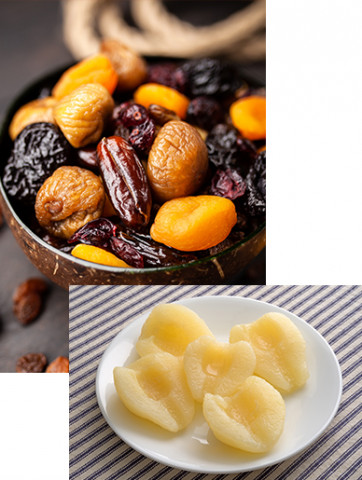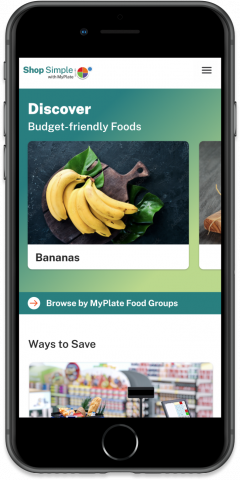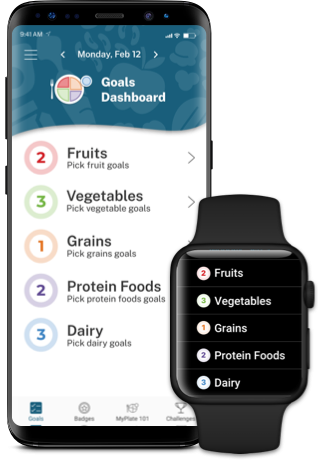Fruits
Focus on whole fruits.
What foods are in the Fruit Group?
The Fruit Group includes all fruits and 100% fruit juice. Fruits may be fresh, frozen, canned, or dried/dehydrated. Fruits can be eaten whole, cut up, puréed (mashed), or cooked. At least half of the recommended amount of fruit eaten should come from whole fruit, rather than 100% fruit juice.
More About the Fruit Group
The table below shows amounts that count as 1 cup from the Fruit Group.
Note: Click on the top row to expand the table. If you are on a mobile device, you may need to turn it to see the full table.
*These are general recommendations by age. Find the right amount for you by getting your MyPlate Plan.
| Daily Recommendations* | ||
|---|---|---|
| Toddlers | 12 to 23 months | ½ to 1 cup |
| Children | 2-3 yrs | 1 to 1½ cups |
| 4-8 yrs | 1 to 2 cups | |
| Girls | 9-13 yrs | 1½ to 2 cups |
| 14-18 yrs | 1½ to 2 cups | |
| Boys | 9-13 yrs | 1½ to 2 cups |
| 14-18 yrs | 2 to 2½ cups | |
| Women | 19-30 yrs | 1½ to 2 cups |
| 31-59 yrs | 1½ to 2 cups | |
| 60+ yrs | 1½ to 2 cups | |
| Men | 19-30 yrs | 2 to 2½ cups |
| 31-59 yrs | 2 to 2½ cups | |
| 60+ yrs | 2 cups | |
| Amount that counts as 1 cup of fruit | |
|---|---|
| Apple |
1 small or ½ large apple 1 cup, sliced or chopped, fresh ⅔ cup, baked ½ cup, dried |
| Applesauce | 1 cup applesauce |
| Banana |
1 large banana 1 cup, sliced ⅔ cup, mashed |
| Blueberries |
1 cup, fresh or frozen ⅓ cup, dried |
| Cantaloupe | 1 cup, diced or melon balls |
| Casaba melon | 1 cup, diced or melon balls |
| Dates |
10 dates ½ cup, whole or cut-up |
| Figs |
5 figs, fresh 10 figs, dried |
| Grapes |
22 seedless grapes 1 cup, whole or cut-up |
| Grapefruit |
1 medium grapefruit 1 cup, sections |
| Guava |
3 guavas 1 cup, sliced or chopped |
| Kiwifruit |
2 to 3 kiwifruits 1 cup, sliced or chopped |
| Kumquats |
10 kumquats 1 cup |
| Mango |
7 slices or chunks, fresh or frozen 1 cup, fresh or frozen ⅓ cup, dried |
| Mixed fruit (fruit cocktail) | 1 cup, diced or sliced, fresh or canned, drained |
| Orange |
1 large orange 1 cup, sections |
| Orange, mandarin | 1 cup, canned, drained |
| Papaya |
1 small papaya 1 cup, sliced or chopped |
| Peach |
1 large peach 1 cup, sliced or diced, fresh, cooked, frozen or canned, drained 2 halves, canned |
| Pear |
1 medium pear 1 cup, sliced or diced, fresh, cooked, or canned, drained |
| Pineapple | 1 cup, chunks, sliced or crushed, fresh, cooked or canned, drained |
| Plum |
3 medium or 2 large plums 1 cup, sliced, fresh or cooked ½ cup, dried (prunes) |
| Strawberries |
About 8 large strawberries 1 cup, whole, halved, or sliced, fresh or frozen |
| Watermelon |
1 small wedge or slice 1 cup, diced or melon balls |
| Dried fruit (raisins, prunes, apricots, figs, etc.) | ½ cup dried fruit |
| 100% fruit juice (orange, apple, grape, grapefruit, etc.) | 1 cup |
Why is it important to eat fruit?
Eating fruit has many health benefits. People who eat fruits and vegetables as part of an overall diet may lower their risk for certain diseases. Fruits provide nutrients needed to maintain your health and body.

Health Benefits
All food and beverage choices matter. Focus on variety, amount, and nutrition.
- Eating foods such as fruits that are lower in calories per cup, instead of other higher calorie foods, may help lower overall calorie intake.
- Eating a diet rich in fruits and vegetables as part of an overall healthy diet may reduce the risk for heart disease, including heart attack and stroke.
- Eating a diet rich in fruits and vegetables as part of an overall healthy diet may protect against certain types of cancers.
- Adding fruit can help increase the amount of fiber and potassium we eat. These are important nutrients that many people do not get enough of.
Food Group Gallery
Do you want to know more about the foods in the Fruit Group? What does a cup or half a cup of fruit look like? Check out the Food Group Gallery! This is a great resource if you want to eat more fruits. It will also help if you want to try something new.
Blackberries, star fruits, kumquats... they’re all waiting for you in the Food Group Gallery.






